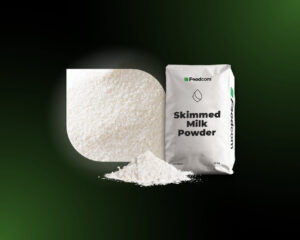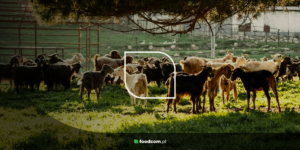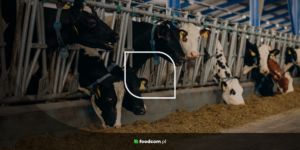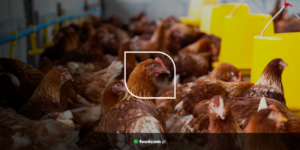- The rise of soy protein concentrate and corn gluten as economical and sustainable protein sources in aquaculture and livestock farming.
- The BeefTwin project using artificial intelligence to improve cattle farming efficiency in the UK.
- Research into the impact of cow feeding behaviour on methane and hydrogen emissions – key to livestock ecology.
- The French feed industry is optimistic about 2025, supporting the development of sustainable practices in the poultry sector.
Welcome to another edition of the Feed Industry Bulletin, in which we regularly report on trends, innovations and events shaping the animal feed market. In this issue, we focus on the growing role of alternative protein sources, sustainability initiatives and key technology projects and research that are impacting the future of the industry. Stay tuned for essential insights and updates to help you succeed.
Soy protein concentrate
In 2024, the market for soy protein concentrate (SPC) for the feed sector is growing rapidly, driven by increasing demand for alternatives to traditional proteins such as fish meal, especially in aquaculture and feeding young farm animals. SPC, being a cheaper option with a high nutritional value due to its essential amino acid content, enables cost-effective feeding of calves, piglets and salmonids. Forecasts predict further growth in the use of SPC in feed, supported by the ethical and environmental benefits of its production, which replaces animal-based ingredients and reduces pressure on natural resources.
The fastest growth in demand for SPC is in the Asia-Pacific region, while in North America a preference for sustainable protein sources is further strengthening the market. Investment in research to improve SPC and the development of efficient distribution methods make it a key product for the modern feed sector.
Maize gluten
The corn gluten feed (CGF) market is growing rapidly in 2024, driven by increasing demand for economical and protein-based feeds for livestock, particularly in the cattle and aquaculture sectors. CGF, which is a by-product of ethanol and corn starch production , is a preferred source of energy and fibre in ruminant nutrition, contributing to increased milk production and body weight. Its nutritional properties allow it to replace more expensive ingredients such as soybean meal, reducing feed production costs.
The increase in popularity of CGF has been observed particularly in North America and Latin America, where the growth of ethanol production has ensured continued access to this feedstock. With availability in wet and dry form, with the dry version preferred for longer distances due to its longer shelf life and lower transport costs, CGF plays a key role as an efficient and sustainable protein source in modern agriculture.
Maltodextrin
Through 2024, the global market for maltodextrin in the feed sector is experiencing steady growth, driven by the versatile use of this additive in animal nutrition. As an easily digestible carbohydrate and source of energy, maltodextrin is valued in feeds where it improves texture, taste and feeding efficiency, promoting growth and condition of livestock. Maize remains the dominant raw material for maltodextrin, accounting for more than half of the market due to its availability and low cost. The market is forecast to grow at an annual rate of around 4.8 per cent until 2034, reaching US$6.58 billion, highlighting maltodextrin’s significant role in the global feed sector.
Monocalciphosphate (MCP)
The monocalciphosphate (MCP) market for the feed sector is set for steady growth in 2024, driven by the need for improved nutritional value in poultry, pigs and fish. MCP provides the key minerals-phosphorus and calcium-necessary for growth, bone development and improved reproductive performance in animals. Due to the high bioavailability of phosphorus, MCP effectively supports feed formulations, optimising their nutritional value and supporting metabolism.
The increase in demand for MCPs is linked to increased global consumption of animal products and the need for high-quality nutrition in intensive livestock systems. At the same time, feed manufacturers, faced with rising raw material costs and environmental pressures, are seeking to implement more sustainable solutions and optimise the use of MCPs to reduce environmental impact and production costs.
News
AI will revolutionise cattle farming in the UK
Artificial intelligence is set to transform the UK beef sector thanks to the £1.2 million UKRI-funded BeefTwin project, led by Professor Xiao Ma of Nottingham Trent University. The project, which aims to improve feed efficiency, reduce greenhouse gas emissions, improve animal welfare and increase profitability, will develop AI-based digital twins of each cow. Working with experts from several universities, the initiative uses real-time data and machine learning to address challenges such as high emissions and low profitability. By supporting innovation and working closely with farmers and policy makers, BeefTwin aims to create a more sustainable and competitive future for UK cattle farming.
Cow feeding habits key to reducing methane emissions
A recent study by Wageningen University found that the feeding behaviour of dairy cows – in particular the size of their meals and the time since their last meal – is key to assessing methane (CH₄) and hydrogen (H₂) emissions using systems such as GreenFeed. The researchers found that how much and when cows eat significantly affects the amount of gases they produce, especially when considering different staple diets and supplements such as 3-nitrooxypropanol (3-NOP). This study highlights the importance of taking into account the eating habits of cows in order to accurately measure and manage greenhouse gas emissions in dairy farming.
French feed producers hope to increase production in 2025
French animal feed producers are cautiously optimistic about an increase in production in 2025, mainly thanks to a recovery in the poultry sector following the challenges of avian influenza, according to SNIA, the national animal feed organisation. Despite the recent setbacks, the industry is committed to local, high-quality feed production and reducing environmental impact, aiming to lower emissions through sustainable ingredients and innovative practices. The SNIA also highlights the need for clear EU guidance on deforestation regulations from 2025, reflecting the industry’s commitment to high environmental and food safety standards.
![What’s up? Feed industry news from Foodcom S.A. [October 2024] What’s up? Feed industry news from Foodcom S.A. [October 2024]](https://foodcom.pl/wp-content/uploads/2024/10/feed-biuletyn-1520x760.png)






